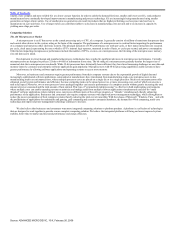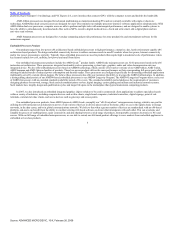AMD 2007 Annual Report Download - page 18
Download and view the complete annual report
Please find page 18 of the 2007 AMD annual report below. You can navigate through the pages in the report by either clicking on the pages listed below, or by using the keyword search tool below to find specific information within the annual report.-
 1
1 -
 2
2 -
 3
3 -
 4
4 -
 5
5 -
 6
6 -
 7
7 -
 8
8 -
 9
9 -
 10
10 -
 11
11 -
 12
12 -
 13
13 -
 14
14 -
 15
15 -
 16
16 -
 17
17 -
 18
18 -
 19
19 -
 20
20 -
 21
21 -
 22
22 -
 23
23 -
 24
24 -
 25
25 -
 26
26 -
 27
27 -
 28
28 -
 29
29 -
 30
30 -
 31
31 -
 32
32 -
 33
33 -
 34
34 -
 35
35 -
 36
36 -
 37
37 -
 38
38 -
 39
39 -
 40
40 -
 41
41 -
 42
42 -
 43
43 -
 44
44 -
 45
45 -
 46
46 -
 47
47 -
 48
48 -
 49
49 -
 50
50 -
 51
51 -
 52
52 -
 53
53 -
 54
54 -
 55
55 -
 56
56 -
 57
57 -
 58
58 -
 59
59 -
 60
60 -
 61
61 -
 62
62 -
 63
63 -
 64
64 -
 65
65 -
 66
66 -
 67
67 -
 68
68 -
 69
69 -
 70
70 -
 71
71 -
 72
72 -
 73
73 -
 74
74 -
 75
75 -
 76
76 -
 77
77 -
 78
78 -
 79
79 -
 80
80 -
 81
81 -
 82
82 -
 83
83 -
 84
84 -
 85
85 -
 86
86 -
 87
87 -
 88
88 -
 89
89 -
 90
90 -
 91
91 -
 92
92 -
 93
93 -
 94
94 -
 95
95 -
 96
96 -
 97
97 -
 98
98 -
 99
99 -
 100
100 -
 101
101 -
 102
102 -
 103
103 -
 104
104 -
 105
105 -
 106
106 -
 107
107 -
 108
108 -
 109
109 -
 110
110 -
 111
111 -
 112
112 -
 113
113 -
 114
114 -
 115
115 -
 116
116 -
 117
117 -
 118
118 -
 119
119 -
 120
120 -
 121
121 -
 122
122 -
 123
123 -
 124
124 -
 125
125 -
 126
126 -
 127
127 -
 128
128 -
 129
129 -
 130
130 -
 131
131 -
 132
132 -
 133
133 -
 134
134 -
 135
135 -
 136
136 -
 137
137 -
 138
138 -
 139
139 -
 140
140 -
 141
141 -
 142
142 -
 143
143 -
 144
144 -
 145
145 -
 146
146 -
 147
147 -
 148
148 -
 149
149 -
 150
150 -
 151
151 -
 152
152 -
 153
153 -
 154
154 -
 155
155 -
 156
156 -
 157
157 -
 158
158 -
 159
159 -
 160
160 -
 161
161 -
 162
162 -
 163
163 -
 164
164 -
 165
165 -
 166
166 -
 167
167 -
 168
168 -
 169
169 -
 170
170 -
 171
171 -
 172
172 -
 173
173 -
 174
174 -
 175
175 -
 176
176 -
 177
177 -
 178
178 -
 179
179 -
 180
180 -
 181
181 -
 182
182 -
 183
183 -
 184
184 -
 185
185 -
 186
186 -
 187
187 -
 188
188 -
 189
189 -
 190
190 -
 191
191 -
 192
192 -
 193
193 -
 194
194 -
 195
195 -
 196
196 -
 197
197 -
 198
198 -
 199
199 -
 200
200 -
 201
201 -
 202
202 -
 203
203 -
 204
204 -
 205
205 -
 206
206 -
 207
207 -
 208
208 -
 209
209 -
 210
210 -
 211
211 -
 212
212 -
 213
213 -
 214
214 -
 215
215 -
 216
216 -
 217
217 -
 218
218 -
 219
219 -
 220
220 -
 221
221 -
 222
222 -
 223
223 -
 224
224 -
 225
225 -
 226
226 -
 227
227 -
 228
228 -
 229
229 -
 230
230 -
 231
231 -
 232
232 -
 233
233 -
 234
234 -
 235
235 -
 236
236 -
 237
237 -
 238
238 -
 239
239 -
 240
240 -
 241
241 -
 242
242 -
 243
243 -
 244
244 -
 245
245 -
 246
246 -
 247
247 -
 248
248 -
 249
249 -
 250
250 -
 251
251 -
 252
252 -
 253
253 -
 254
254 -
 255
255 -
 256
256 -
 257
257 -
 258
258 -
 259
259 -
 260
260 -
 261
261 -
 262
262 -
 263
263 -
 264
264 -
 265
265 -
 266
266 -
 267
267 -
 268
268 -
 269
269 -
 270
270 -
 271
271 -
 272
272 -
 273
273 -
 274
274 -
 275
275 -
 276
276 -
 277
277 -
 278
278 -
 279
279 -
 280
280 -
 281
281 -
 282
282 -
 283
283 -
 284
284 -
 285
285 -
 286
286 -
 287
287 -
 288
288 -
 289
289 -
 290
290 -
 291
291 -
 292
292 -
 293
293 -
 294
294 -
 295
295 -
 296
296 -
 297
297 -
 298
298
 |
 |

Table of Contents
improvements. Our ability to compete depends on our ability to develop, introduce and sell new products or enhanced versions of existing products on a timely
basis and at competitive prices, while reducing our manufacturing costs.
Competition in the Microprocessor Market
Intel Corporation has dominated the market for microprocessors for many years. Intel’s market power and significant financial resources enable it to
market its products aggressively, to target our customers and our channel partners with special incentives and to discipline customers who do business with us.
These aggressive activities have in the past and are likely in the future to result in lower unit sales and average selling prices for our products, and adversely
affect our margins and profitability. As long as Intel remains in this dominant position, we may be materially adversely affected by Intel’s:
• business practices, including rebating, and allocation strategies and pricing actions, designed to limit our market share;
• product mix and introduction schedules;
• product bundling, marketing and merchandising strategies;
• exclusivity payments to its current and potential customers;
• control over industry standards, PC manufacturers and other PC industry participants, including motherboard, memory, chipset and basic input/output
system, or BIOS, suppliers and software companies as well as the graphics interface for Intel platforms; and
• marketing and advertising expenditures in support of positioning the Intel brand over the brand of its OEM customers.
Intel exerts substantial influence over computer manufacturers and their channels of distribution through various brand and marketing programs. Because
of its dominant position in the microprocessor market, Intel has been able to control x86 microprocessor and computer system standards and to dictate the type of
products the microprocessor market requires of Intel’s competitors. Intel also dominates the computer system platform, which includes core logic chipsets,
graphics chips, motherboards and other components necessary to assemble a computer system. As a result, OEMs that purchase microprocessors for computer
systems are highly dependent on Intel, less innovative on their own and, to a large extent, are distributors of Intel technology. Additionally, Intel is able to drive
de facto standards for x86 microprocessors that could cause us and other companies to have delayed access to such standards.
We expect Intel to maintain its dominant position in the microprocessor market and to continue to invest heavily in marketing, research and development,
new manufacturing facilities and other technology companies. Intel has substantially greater financial resources than we do and accordingly spends substantially
greater amounts on research and development and production capacity than we do. We expect intense competition from Intel to continue.
Competition in the Embedded Processor Market
With respect to our embedded processors, our principal competitors are Freescale Semiconductor, Inc., Intel Corporation, NEC Corporation, Toshiba
Corporation, Broadcom Corporation, Raza Microelectronics, Inc., Applied Micro Circuits Corporation, Marvell Technology Group Ltd. and VIA Technologies,
Inc. We expect competition in the market for these devices to increase as our principal competitors focus more resources on developing low-power embedded
processor solutions.
13
Source: ADVANCED MICRO DEVIC, 10-K, February 26, 2008
